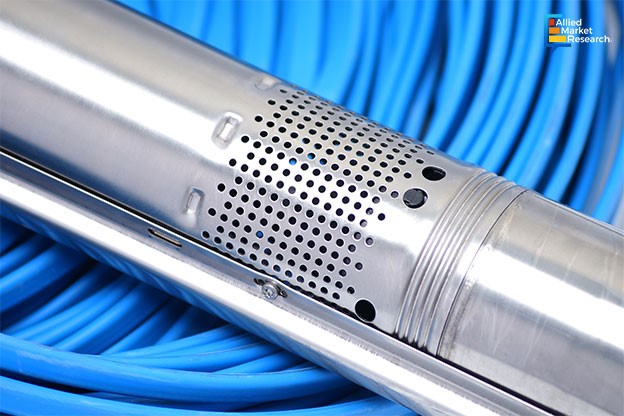Electric Submersible Pumps: The Power beneath the Surface

31 Mar
2025
Highlights:
- Introduction
- Versatile Applications of ESPs
- Recent breakthroughs in the industry
Electric submersible pumps (ESPs) are essential for efficiently lifting fluids from deep wells, particularly in the oil and gas sector. These pumps operate with a sealed electric motor connected to a multistage centrifugal pump, both submerged in the fluid they extract. This design minimizes cavitation issues and enhances efficiency, making ESPs a preferred choice for challenging environments. Their ability to function effectively under high-pressure and high-temperature conditions makes them indispensable for industries that rely on continuous and high-volume fluid extraction.
What makes an ESP work so efficiently?
At the core of an ESP system is a multistage pump that pressurizes the fluid, allowing it to reach the surface with ease. The pump is driven by a sealed electric motor that withstands extreme conditions, while a seal-chamber section protects the motor from well fluids and equalizes pressure. A durable power cable delivers electricity from the surface, ensuring seamless operation even in harsh downhole environments. Each of these components works in harmony to maintain efficiency and reliability in deep wells.
Diverse uses that make ESPs invaluable
Electric submersible pumps are widely used across multiple industries, particularly in oil and gas extraction. They play a key role in primary recovery, utilizing natural reservoir pressure to lift fluids to the surface. When reservoir pressure drops, ESPs assist in secondary recovery through methods like waterflooding. Enhanced oil recovery (EOR) techniques, such as steam injection, further increase extraction efficiency. In offshore and deepwater drilling, ESPs perform reliably even at depths exceeding 1,500 meters. They play an important role in heavy oil production, helping lift viscous fluids smoothly. Additionally, ESPs help sustain production in mature wells, remove liquids that block gas flow, and extract resources from unconventional reservoirs like shale formations. The electric submersible pump industry is expected to gather a revenue of $19.7 billion by 2033. The market accounted for $10.4 billion in 2023 and is projected to rise at a CAGR of 6.5% during 2024-2033.
Why industries depend on ESPs
The high efficiency of ESPs allows them to handle large fluid volumes, making them ideal for high-production environments. Their versatility enables them to operate in various well configurations, including deviated or horizontal wells. With a compact surface footprint, they are especially useful for offshore platforms and environmentally sensitive areas. Moreover, they operate with minimal noise, reducing both environmental and community impact. These advantages make ESPs a preferred solution for industries looking to maximize extraction while minimizing operational disruptions.
Challenges that threaten performance and their solutions
Despite their many advantages, ESPs face several operational challenges. Installation and maintenance require specialized equipment and expertise, but comprehensive training, predictive maintenance, and advanced tools can simplify the process. Scale buildup and corrosion can damage pumps, but chemical treatments, durable materials, and regular cleaning help prevent this. Power supply issues in remote areas can be managed using backups, voltage regulators, or alternative energy sources. The presence of gas and sand in reservoirs can disrupt pump performance, yet gas separators, sand control measures, and real-time monitoring technologies help maintain efficiency. High temperatures and pressures also put stress on ESP components, but using materials designed for extreme conditions, implementing thermal management strategies, and continuous pressure monitoring ensure long-term reliability.
Recent developments transforming the ESP industry
Franklin Electric made a major move by acquiring Australia's PumpEng in early 2025. PumpEng specializes in submersible pumps tailored for the mining sector, and this acquisition strengthens Franklin Electric’s position in the industry. Franklin Electric is strengthening its mining capabilities by combining PumpEng’s expertise with its Pioneer Pump and Minetuff brands. Another notable development came in December 2024, when ProPetro Holdings launched ProPetro Energy Solutions LLC (ProPWR), a new subsidiary dedicated to providing mobile natural gas-fueled power generation. This move caters to the growing demand for electrification in the oil and gas industry, including solutions for powering ESPs.
Closing lines
Industries are moving toward sustainability. Electric submersible pumps are transforming industries by offering efficient and reliable fluid extraction solutions. Their ability to function in extreme conditions, coupled with ongoing technological improvements, makes them an essential component of modern extraction processes.
Contact our experts to learn about key growth drivers and investment opportunities!

Koyel Ghosh
Author’s Bio- Koyel Ghosh is a blogger with a strong passion and enjoys writing in miscellaneous domains, as she believes it lets her explore a wide variety of niches. She has an innate interest in creativity and enjoys experimenting with different writing styles. A writer who never stops imagining, she has been serving the corporate industry for the last five years.
Food Vacuum Cleaning Equipment: Increased Packaged Foods Consumption Driving Industry Growth
Avenue: Entire Library membership of Allied Market Research Reports at your disposal
- Avenue is an innovative subscription-based online report database.
- Avail an online access to the entire library of syndicated reports on more than 2,000 niche industries and company profiles on more than 12,000 firms across 11 domains.
- A cost-effective model tailored for entrepreneurs, investors, and students & researchers at universities.
- Request customizations, suggest new reports, and avail analyst support as per your requirements.
- Get an access to the library of reports at any time from any device and anywhere.
Related Post
-
How are Submarine Cables Transforming Global Connectivity with Enhanced User Experience?
-
Endoscopy Procedures: Transformations in Techniques and Applications
-
AI-Powered Video Analytics: How the Product Actually Works for enterprises
-
Painting Robots: Transforming Precision Coating and Creative Applications
-
Innovations in Pharmacovigilance Systems Advancing Patient Safety
-
Understanding Edge Security: Keeping Data Safe Near the Source
-
Exploring the Use and Advancements of 3D Laser Scanners in Professional Applications
-
Reinforcing Industrial Controls with Smarter Tools and Training








